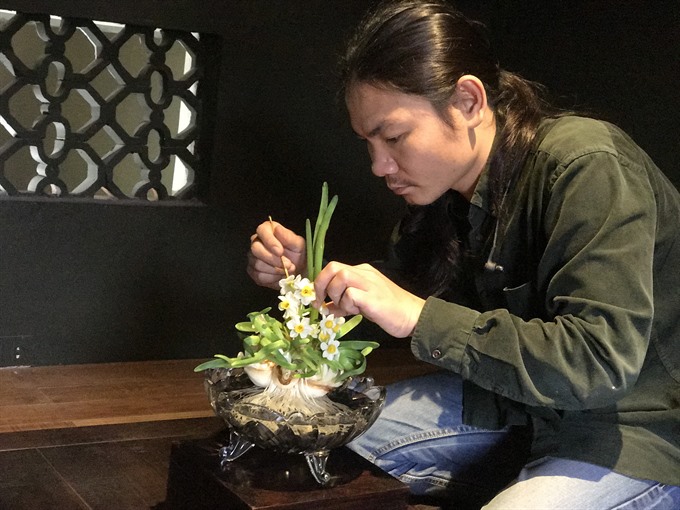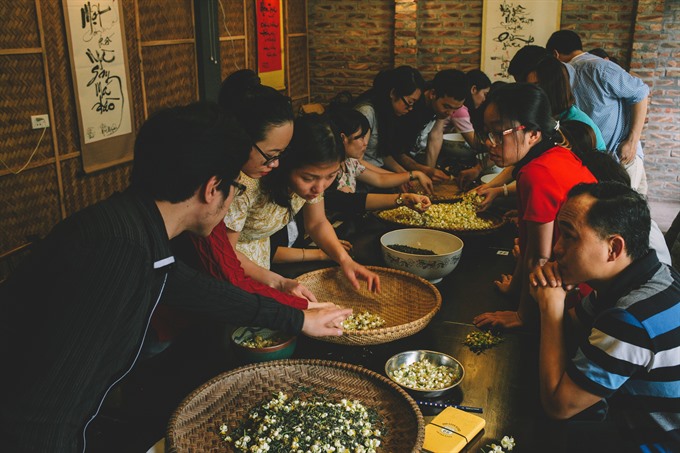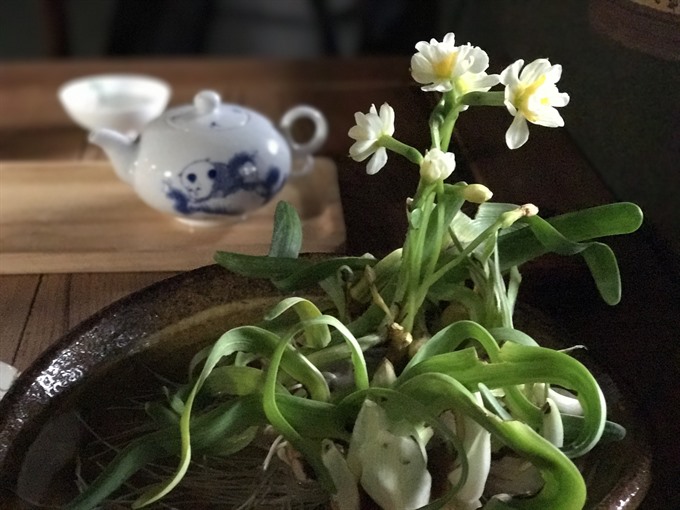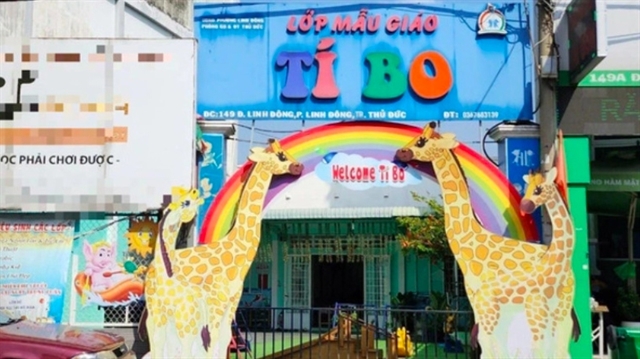 Features
Features

In the heart of Hà Nội, Thưởng Trà presents a secluded place for those who enjoy quietitude, the fragrance of flowers and an ancient drinking tradition. Lê Hương reports.
 |
| Soft touch: Bắc is among very few people who still use narcissus flowers to scent their tea, which is challenging as it is a very fragile flower. He grows the flower on the Lunar New Year occasion. VNS Photo Lê Hương |
In the heart of Hà Nội, Thưởng Trà presents a secluded place for those who enjoy quietitude, the fragrance of flowers and an ancient drinking tradition. Lê Hương reports.
Carefully scattering a layer of grapefruit flowers on the surface of dried green tea leaves wrapped in several thin tissue papers, all stored in a small ceramic bowl, Nguyễn Việt Bắc slowly explains the process of preparing scented tea.
He performs all the tasks, such as choosing the right flowers, treating the flowers, blending them with the tea leaves in layers, wrapping the mixture and then waiting for the final product. In between all this, he sometimes stops to answer questions.
The audience of around 20 people, mostly in their early 20s, follow his directions attentively. Some carefully take notes while others take photos of the various scenting stages.
The warm scent of grapefruit flowers overwhelms the room, which used to be an apartment on the third floor of an old building near the Old Quarter of Hà Nội. Time seems to crawl here, despite the hustle and bustle outside.
This is a regular feature at Bắc’s tea shop.
The tea shop provides both its regular visitors and first-time guests a relaxing ambience under the warm glow of yellow lights with soft, gentle music.
The furniture in the shop are stacked neatly with tables placed far enough from one another to secure privacy. You may choose to sit outside in the balcony or indoors.
Tanks of fish, pots of flowers and bonsai, sculptures and cages of birds embellish the room.
“The more I come here, the more I notice the care with which the owner has placed the furniture tables, chairs, ceramic cups, kettles and containers,” said Huỳnh Trung, a customer, while sniffing in the scent from his hot cup of tea.
“We have different kinds of containers here, as we offer a variety of tea,” Bắc said. “The tea is my focus, while the other objects, containers and the ambience have to complement the tea I offer. Different kinds of tea require suitable kettles and cups, as they are boiled at different temperatures.”
At the tea shop, customers are not only treated to a variety of tea, but also can watch the tea-makers in action.
 |
| Floral tea: People learn how to make grapefruit flower scented tea. Photo courtesy of Thưởng Trà |
The shop also offers regular workshops on preparing scented tea using seasonal flowers such narcissus and grapefruit in spring, and lotus in summer.
“There are many kinds of scented tea in Việt Nam such as ngâu (mock lemon) tea, lotus-scented tea, nhài (jasmine) tea, mộc (Osmanthus fragrans) tea and cúc (chrysanthemum) -scented tea,” Bắc said. “People tend to think that scented teas are difficult to make. I show people that everyone, even youngsters, can do it following my steps. I have simplified the process for each flower.”
Hà Thị Trà My, a young attendee at the workshop, cannot hide her excitement after the guidance.
“I don’t think it so simple, but it is interesting,” she said. “It is important to choose the right flowers and tools. He is well-experienced and a dedicated tea-maker. I highly appreciate his sharing his knowledge.”
Keeping ancient scent
Bắc has specialised in gathering leaves from old tea trees up in the high mountains in northern provinces such as Sơn La and Lai Châu for the past few years. He also plants organic tea without using pesticides and chemical fertilisers.
Bắc has been considered as one of the most experienced tea-maker in Hà Nội, who processes fresh tea leaves and scents the tea manually.
Bắc is among the rare breed of people who still use narcissus flower to scent their tea, which is challenging as narcissus is fragile.
Bắc places narcissus flowers and tea leaves into a small ceramic bowl, layer by layer. Each bowl is wrapped in a tissue and stored in a cool place for 24 hours to 36 hours, depending on the weather. The bowl of tea should be scented with flowers at least four times before it can be enjoyed.
“In small bowls, I can control the humidity and it is easier to keep the flowers intact,” he said. “The scent of narcissus easily wears off, as its petals are fragile. Before putting each narcissus into the bowl, I have to dry its pedicle to remove its resin, which may cause allergic reaction in some people.”
That’s why Bắc prepares a small amount of narcissus-scented tea every spring, but he does not encourage others to make it.
Nguyễn Đức Dũng, a narcissus lover, who raises the flowers every Lunar New Year season, expresses his satisfaction while sipping hot narcissus-scented tea made by Bắc.
“I feel inside the bitter taste of tea an ancient fragrance hides there,” he said. “I am sure no one makes the same kind of tea now.”
Dũng recalls a piece by writer Vũ Bằng (1913-1984) he has read before. The writer mentions a memory of visiting his mother in his hometown in the northern province of Hải Dương. The mother makes some tea for the writer who sips it and asks: “Mother, what kind of tea is it? It’s scented and so sweet.” The mother replies, "That’s narcissus-scented tea."
“Now, the process to prepare narcissus tea is handed down only in such exquisite families, where people have plenty of time to enjoy tea,” Bắc said. — VNS
 |
| Reflective: The tea shop provides a relaxing ambience under the warm glow of yellow lights with soft, gentle music. VNS Photo Lê Hương |




.jpg)




.jpg)